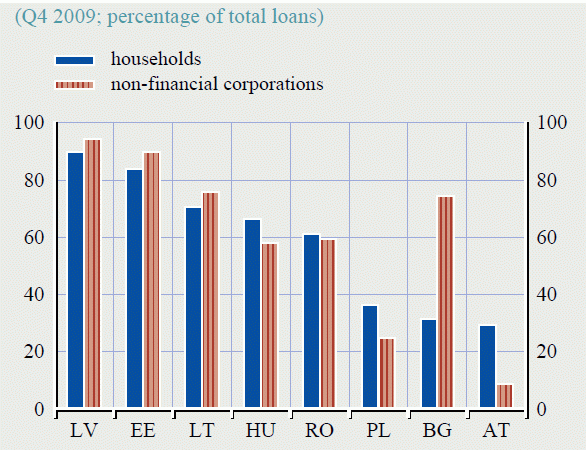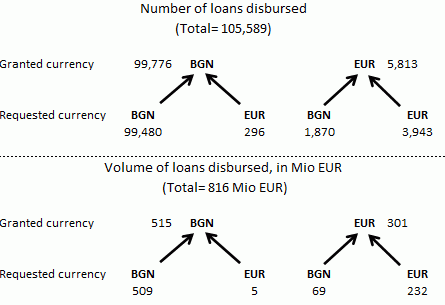A large share of firms and households in Eastern Europe borrow in a foreign currency, i.e. the euro or Swiss franc, rather than in their domestic currency (see Figure 1). Unhedged foreign currency (FX) borrowing by the private sector is seen as a major threat to financial stability in the region and has led to a strong response from national authorities. For example, supervisors in Poland and Hungary have encouraged banks to disclose the exchange rate risks of FX loans to clients and to tighten the eligibility criteria for such loans, while Romania and Croatia have also imposed stronger provisioning requirements on FX loans.
The call for policies to curb FX lending in Eastern Europe has intensified in recent months. In June 2010, the European Central Bank (ECB) called for coordinated efforts including regulators from the home countries of banks which own subsidiaries in Eastern Europe. The European Bank for Reconstruction and Development (EBRD) has also announced efforts to promote local currency wholesale funding of banks in the region (Mirow 2010).
Is it push or pull?
Both the ECB and the EBRD argue that FX lending in the region is partly supply-side driven, with foreign currency funding of banks, often by their parent banks, at the heart of the problem. Cross-country comparisons of aggregate lending, suggest that FX funding of banks, both from the interbank market as well as from depositors is correlated with foreign-currency lending (Luca and Petrova 2008, Basso et al. 2007, Rosenberg and Tirpak 2008). However, these studies cannot disentangle whether it is FX funding of banks which is driving their FX lending or vice versa.
Figure 1. Loans in foreign currency to the domestic non-financial sector, selected EU countries.
Source: ECB, Financial Stability Review, June 2010.
Disentangling the demand-side from the supply-side drivers of FX loans
In a recent study we provide micro evidence that FX lending in Eastern Europe is at least partly supply-side driven (Brown et al. 2010). We examine how the currency denomination of loans is determined in the negotiation process that takes place between small firms and one retail bank in Bulgaria.
In Bulgaria, as in other Eastern European countries, foreign currencies and especially the euro play an important role for domestic financial transactions, with 40% of deposits and 47% of loans denominated in euros. The bank at the heart of our analysis is focused on retail lending, making it an interesting object of study, since especially retail clients seem to have been most involved in foreign currency transactions throughout Eastern Europe. As with the majority of banks in the region, the bank is mainly foreign owned and has substantial wholesale funding in foreign currency.
Our analysis is based on information for 105,589 business loans granted to over 60,000 firms during the period 2003-2007. In contrast to previous studies on loan currency choice (Brown et al. 2009), we observe not only the currency as stated in the loan contract but also the borrower’s requested currency. We are therefore able to examine to what extent the currency denomination of loans is determined by the demand and/or supply side and which are the driving factors on either side.
The demand for foreign-currency loans
Looking at the demand for foreign-currency loans, our data shows that less than 5% of the loans and less than one-third of the loan volume (29%) are requested in euros (see Figure 2). We find that firms are more likely to request a euro loan when the interest differential between the Bulgarian lev and euro is higher, when the requested loan size is higher and when the requested loan maturity is longer. The request for a euro loan is also positively related to foreign currency revenue and financial transparency of the firm, while it is negatively related to the potential distress costs of the firm in the case of bankruptcy.
The supply of foreign-currency loans
Looking at the supply of FX loans we find striking evidence that our bank is “pushing” euro loans. Roughly one-third (32%) of all loans extended in euros in our sample and nearly one-quarter of the euro loan volume (23%) are loans that were initially requested in lev. Examining the sub-sample of loans which were requested in lev, we find that the bank is more likely to switch the loan to euros if the firm is of lower observable credit risk. Worryingly though, we also find that the bank is hesitant to offer large and long-term loans in local currency. Further, the bank is more likely to switch a loan to euros after it has received additional customer funding in euros. However, we do not find that the bank pushes FX loans after it has received more wholesale funding in euros. The latter results suggest that while FX lending may be driven by customer funding in FX, the causality between FX lending and wholesale FX funding might go the other way.
Figure 2. Requested and granted loan currency
Source: Brown, Kirschenmann and Ongena, 2010.
Reducing wholesale FX funding of banks may not do the job
Our results show that foreign-currency lending is not only driven by firms and households who try to benefit from lower interest rates. A substantial share of foreign currency retail loans in Eastern Europe may be supply-driven with banks hesitant to lend long-term in local currency and eager to match the currency structure of their assets with that of their customer liabilities.
Based on the above results we conclude that recent proposals to foster local currency wholesale funding in Eastern Europe may not be sufficient to reduce FX lending. Instead, credible macroeconomic policies which encourage customers to save in local currency and will make banks less hesitant to extend long-term loans in local currency may be more promising.
References
Basso, HS, O Calvo-Gonzalez, and M Jurgilas (2007), “Financial Dollarization and the Role of Banks and Interest Rates”, European Central Bank, Working Paper 748.
Brown, M, S Ongena, and P Yesin (2009), “Foreign Currency Borrowing by Small Firms”, CEPR Discussion Paper 7540.
Brown, M, K Kirschenmann, and S Ongena (2010), “Foreign Currency Loans - Demand or Supply Driven?”, CEPR Discussion Paper 7952.
Mirow, Thomas (2010), “Cross-Border Banking in the Transition Region: Lessons from the Crisis and Beyond”, EBRD, 13 May.
Luca, A and I Petrova (2008), “What drives Credit Dollarization in Transition Economies?”, Journal of Banking and Finance, 32, 858-869.
Rosenberg, CB, and M Tirpak (2008), “Determinants of Foreign Currency Borrowing in the New Member States of the EU”, IMF Working Paper 08/173.







